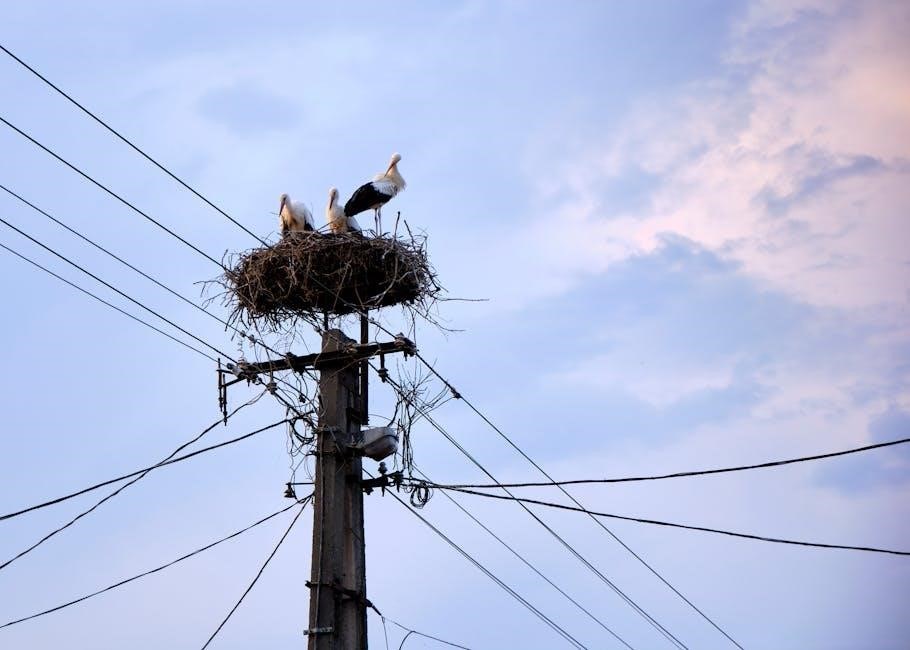nest thermostat wiring guide

Nest thermostats are innovative, energy-efficient devices designed to enhance home comfort and reduce energy bills. They offer advanced smart features, compatibility with various HVAC systems, and a user-friendly interface. This guide provides a detailed wiring overview to ensure a smooth installation process, whether you’re upgrading or installing a new system.
Preparing for Installation
Before installing your Nest thermostat, proper preparation is essential to ensure a smooth process. Start by turning off the power to your HVAC system at the circuit breaker or fuse box. Locate your existing thermostat and take clear photos of the wiring for reference. Consult the Nest wiring diagram specific to your system, which can be found in the installation guide or online resources. Gather all necessary tools, such as a screwdriver, wire labels, and a drill (if mounting in a new location). If your system lacks a C-wire, consider using the Nest Power Connector Kit to avoid compatibility issues. Unpack the Nest thermostat and its accessories, ensuring all components are included. Familiarize yourself with the Nest app, as it will guide you through the installation process. Finally, set aside enough time to complete the installation without rushing, as this will help prevent errors. Proper preparation ensures a successful and stress-free installation experience.

Understanding the Wiring
Understanding the wiring is crucial for a successful Nest thermostat installation. Most thermostats use a standard wiring configuration, typically involving 4-6 wires labeled R, W, Y, G, C, and sometimes an additional wire for heat pumps. The R wire connects to the heating system, while W controls the heating stage. Y and G wires handle cooling and fan operations, respectively. The C wire provides constant power, essential for smart features, though it’s not always present in older systems. If your system lacks a C wire, consider using the Nest Power Connector Kit to ensure compatibility. Familiarize yourself with the wiring diagram provided by Nest, which outlines the correct connections for your specific HVAC setup. Properly identifying each wire’s function prevents errors and ensures safe installation. If unsure, refer to your HVAC system’s manual or consult a professional to avoid potential risks. Accurate wiring is key to optimizing your Nest thermostat’s performance and smart capabilities.
Removing the Old Thermostat
Before installing your Nest thermostat, you must safely remove the old one. Start by turning off the power to your HVAC system at the circuit breaker or fuse box. Verify the system is off by checking that the thermostat screen is blank and the heating or cooling unit is inactive. Next, carefully remove the thermostat cover to access the wiring. Take a clear photo of the wires and their connections for reference during the Nest installation. Label each wire with its function (e.g., R, W, Y, G, C) using sticky notes or a marker. Gently pull the wires out of the old thermostat and set the unit aside. If the wires are stuck, use a screwdriver to release them from the base. Remove any screws holding the old thermostat base to the wall. For older systems, you may need to use a screwdriver to release wires from connectors. Once the old thermostat is removed, inspect the wiring for damage or wear. Dispose of the old thermostat responsibly. This step ensures a clean start for your Nest installation.

Installing the Nest Thermostat
Mount the Nest base to the wall using the provided screws or the optional trim plate for a cleaner look. Insert the wires into the base connectors, following the wiring diagram from the app. Power on the system and complete the setup process through the Nest app to configure smart features and ensure compatibility with your HVAC system. This step ensures a seamless and safe installation process.
Connecting the Wires
Connecting the wires is a critical step in the Nest Thermostat installation process. Ensure the power to your HVAC system is turned off before starting. Identify each wire by its label (R, W, Y, G, C, etc.) and match them to the corresponding terminals on the Nest base. Use the Nest app to guide you through the wiring process and verify compatibility with your system. For systems requiring a common wire (C), check if your setup already has one or if a workaround is needed. Insert each wire firmly into the press connectors on the Nest base, ensuring they are fully seated. If you have an OpenTherm boiler, connect the control circuit to the OT1 and OT2 terminals. Double-check all connections to avoid errors. Once wired, proceed to mount the Nest Thermostat and power it on to complete the setup through the app.
Mounting the Base
Mounting the Nest Thermostat base securely is essential for proper functionality. Begin by removing the old thermostat and taking note of the wiring configuration. Use the provided Nest screws or a drill to create pilot holes if necessary. Ensure the wall surface is level by using the built-in leveling tool on the back of the Nest base. Gently press the base onto the wall, making sure it aligns with the screws. For drywall or plaster walls, insert the provided drywall anchors first for added stability. Tighten the screws firmly but avoid over-tightening, which could damage the base or wall. If you prefer not to drill into the wall, you can use the optional Nest stand to place the thermostat on a flat surface instead. Once mounted, ensure the base is stable and even before proceeding to connect the wires. The Nest app will guide you through the next steps of the installation process.

Advanced Configurations
Advanced configurations for Nest thermostats include integrating smart features like geofencing, smart scheduling, and energy reports. Users can also customize settings for multi-stage systems, dual fuel setups, and OpenTherm compatibility, ensuring optimal performance for complex HVAC systems.

Setting Up Smart Features
Setting up smart features on your Nest thermostat enhances its functionality and energy efficiency. Start by connecting the thermostat to your Wi-Fi network through the Nest app. This enables remote access, allowing you to adjust settings from your smartphone or tablet. Geofencing is another smart feature that uses your location to automatically switch between home and away modes, optimizing energy usage. Additionally, the Nest Learning feature learns your temperature preferences over time and creates a schedule tailored to your habits. For voice control, integrate the thermostat with Google Home or other compatible smart home systems. Energy reports provide insights into your usage patterns, helping you save even more. These advanced configurations ensure your Nest thermostat operates seamlessly, combining convenience, efficiency, and innovation for a smarter home experience.
Testing the System
After installing your Nest thermostat, it’s crucial to test the system thoroughly to ensure everything works as expected. Start by turning on the power to your HVAC system and checking if the thermostat display lights up. Verify that the device successfully connects to your Wi-Fi network for smart features to function properly. Test each mode—heat, cool, and fan—to confirm the system responds correctly. Check for any error messages, which may indicate wiring issues or compatibility problems. Ensure the thermostat cycles on and off smoothly and that the temperature adjustments are accurate. Additionally, test geofencing and remote access through the Nest app to confirm smart features are operational. If you’ve integrated voice control with Google Home or other systems, test these commands as well. Finally, run a full heating and cooling cycle to ensure the system operates seamlessly. If everything functions correctly, your Nest thermostat is ready for everyday use.
Congratulations! You’ve successfully installed your Nest thermostat and navigated the wiring process. By following this guide, you’ve ensured a seamless integration with your HVAC system, unlocking advanced smart features that enhance comfort and energy efficiency. If you encounter any issues, refer to the troubleshooting section or consult a professional. Regularly update your thermostat’s software to access new features and optimize performance. Remember to monitor and adjust settings via the Nest app to maximize energy savings. With proper care, your Nest thermostat will provide reliable service for years, helping you conserve energy and enjoy a smarter home environment. If additional assistance is needed, visit the official Nest support page or contact customer service. Enjoy the convenience and benefits of your new smart thermostat!



Leave a Reply
You must be logged in to post a comment.